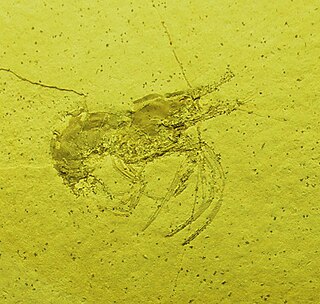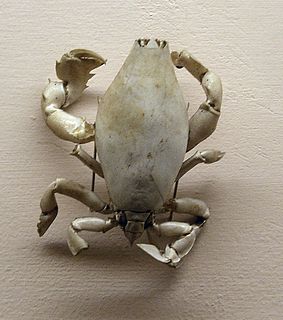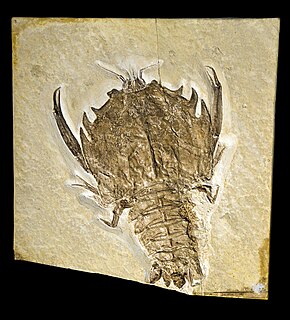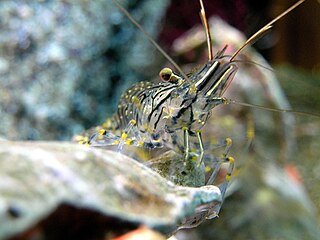
Bylgia is an extinct genus of prawns in the family Penaeidae, containing 4 species.

Anomura is a group of decapod crustaceans, including hermit crabs and others. Although the names of many anomurans include the word crab, all true crabs are in the sister group to the Anomura, the Brachyura.

Raninoida is a taxonomic section of the crabs, containing a single superfamily, Raninoidea. This group of crabs is unlike most, with the abdomen not being folded under the thorax. It comprises 46 extant species, and nearly 200 species known only from fossils.

The family Polychelidae contains thirty-eight extant species of blind, benthic lobster-like crustaceans. They are found throughout the world's tropical, sub-tropical and temperate oceans, including the Mediterranean Sea and the Irish Sea.

Nephropoidea is a superfamily of decapod crustaceans. It contains the true lobsters in the Nephropidae, and three fossil families: Chilenophoberidae, Protastacidae and Stenochiridae. Their closest relatives are the reef lobsters.
Cyclodorippoida is a group of crabs, ranked as a section. It contains the single superfamily Cyclodorippoidea, which holds three families, Cyclodorippidae, Cymonomidae and Phyllotymolinidae.

Polychelida is an infraorder of decapod crustaceans. Fossil representatives are known dating from as far back as the Upper Triassic. A total of 38 extant species, all in the family Polychelidae, and 55 fossil species have been described.

Eubrachyura is a group of decapod crustaceans comprising the more derived crabs. It is divided into two subsections, based on the position of the genital openings in the two sexes. In the Heterotremata, the openings are on the legs in the males, but on the sternum in females, while in the Thoracotremata, the openings are on the sternum in both sexes. This contrasts with the situation in other decapods, in which the genital openings are always on the legs. Heterotremata is the larger of the two groups, containing the species-rich superfamilies Xanthoidea and Pilumnoidea and all the freshwater crabs (Gecarcinucoidea, Potamoidea. The eubrachyura is well known for actively and constantly building its own burrows. The fossil record of the Eubrachyura extends back to the Cretaceous; the supposed Bathonian representative of the group, Hebertides jurassica, ultimately turned out to be Cenozoic in age.

Erymidae is a family of decapod crustaceans known only from fossils. They survived for 100 million years, from the Permo-Triassic boundary to the Albian. Eleven genera are recognised:
Acantholambrus is an extinct genus of crab. It contains the single species Acantholambrus baumi, and was named by Blow and Manning in 1996.

Polycheles typhlops is a species of blind, deep water decapod crustacean with a cosmopolitan distribution. It is "one of the dominant and most characteristic crustaceans in deep-sea communities of the Mediterranean Sea".

Polycheles sculptus is a species of "strange, blind crustacean" resembling a prawn or a squat lobster. It has a cosmopolitan distribution in deep water, being found on both sides of the Atlantic Ocean, in the Mediterranean Sea, and across much of the Indo-West Pacific, at depths of 200–4,000 metres (660–13,120 ft).

Antrimpos is an extinct genus of crustacean which existed during the Triassic and Jurassic periods. It contains 15 species, including Antrimpos speciosus.

Eryonidae is a family of fossil decapod crustaceans which lived from the Upper Triassic to the Lower Cretaceous. It contains four genera: An aggregation of three unidentified eryonids was reported in 2012 inside a Late Jurassic ammonoid of the species Harpoceras falciferum; they represent the earliest evidence of gregarious behaviour in decapods.

Longichela orobica is an extinct species of prawn which lived in the Norian, and is the only species in the genus Longichela.
Paleomattea is an extinct genus of prawn, containing the single species Paleomattea deliciosa. The species is only known from the stomach contents of the fish Rhacolepis, which is referred to by the specific epithet deliciosa ("delicious"), and in the generic name, where mattea means "delicacy".

Palaemonoidea is a large superfamily of shrimp, containing nearly 1,000 species. The position of the family Typhlocarididae is unclear, although the monophyly of a group containing the remaining seven families is well supported.

Campylonotoidea is a superfamily of shrimp, containing the two families Campylonotidae and Bathypalaemonellidae. Fenner A. Chace considered it to be the sister group to the much larger superfamily Palaemonoidea, with which it shares the absence of endopods on the pereiopods, and the fact that the first pereiopod is thinner than the second. Using molecular phylogenetics, Bracken et al. proposed that Campylonotoidea may be closer to Atyoidea. There are sixteen described species in 3 genera; no fossils are known.

Eryma is a genus of fossil lobster-like crustaceans, containing 44 species.

Coleiidae is a family of fossil decapod crustaceans, containing the following genera:














